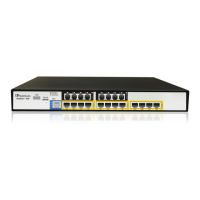User's Manual 324 Document #: LTRT-12809
Mediant 800 MSBR
25.8.3 Reason Header
The device supports the SIP Reason header according to RFC 3326. The Reason header
conveys information describing the disconnection cause of a call:
Sending Reason header: If a call is disconnected from the Tel side (ISDN), the
Reason header is set to the received Q.850 cause in the appropriate message
(BYE/CANCEL/final failure response) and sent to the SIP side. If the call is
disconnected because of a SIP reason, the Reason header is set to the appropriate
SIP response.
Receiving Reason header: If a call is disconnected from the IP side and the SIP
message includes the Reason header, it is sent to the Tel side according to the
following logic:
• If the Reason header includes a Q.850 cause, it is sent as is.
• If the Reason header includes a SIP response:
♦ If the message is a final response, the response status code is translated to
Q.850 format and passed to ISDN.
♦ If the message isn’t a final response, it is translated to a Q.850 cause.
• When the Reason header is received twice (i.e., SIP Reason and Q.850), the
Q.850 takes precedence over the SIP reason and is sent to the Tel side.
25.8.4 Mapping PSTN Release Cause to SIP Response
The device's FXO interface interoperates between the SIP network and the PSTN/PBX.
This interoperability includes the mapping of PSTN/PBX Call Progress tones to SIP 4xx or
5xx responses for IP-to-Tel calls. The converse is also true - for Tel-to-IP calls, the SIP 4xx
or 5xx responses are mapped to tones played to the PSTN/PBX.
When establishing an IP-to-Tel call, the following rules are applied:
If the remote party (PSTN/PBX) is busy and the FXO device detects a busy tone, it
sends a SIP 486 Busy response to IP. If it detects a reorder tone, it sends a SIP 404
Not Found (no route to destination) to IP. In both cases the call is released. Note that
if the 'Disconnect Call on Busy Tone Detection' parameter is set to Disable, the FXO
device ignores the detection of busy and reorder tones and does not release the call.
For all other FXS/FXO release types such as:
• no free channels in the Trunk Group,
• an appropriate call routing rule to a Trunk Group doesn’t exist, or
• the phone number isn’t found
then the device sends a SIP response to the IP according to the 'Default Release
Cause' parameter. This parameter defines Q.931 release causes. Its default value is
3, which is mapped to the SIP 404 response. By changing its value to 34, the SIP 503
response is sent. Other causes can be used as well.

